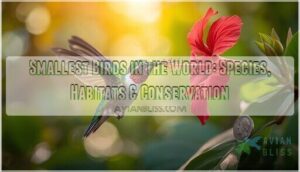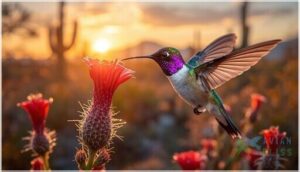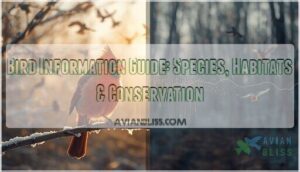This site is supported by our readers. We may earn a commission, at no cost to you, if you purchase through links.
 A bird that weighs less than a dime—that’s not science fiction, it’s the Bee Hummingbird. At just 1.95 grams and 5.5 centimeters long, this Cuban marvel claims the title of the world’s smallest bird, beating its wings 80 times per second to stay airborne.
A bird that weighs less than a dime—that’s not science fiction, it’s the Bee Hummingbird. At just 1.95 grams and 5.5 centimeters long, this Cuban marvel claims the title of the world’s smallest bird, beating its wings 80 times per second to stay airborne.
But size isn’t a limitation for these tiny aviators; it’s a superpower. Their diminutive stature unlocks specialized adaptations that larger birds can only dream of—from precision feeding with elongated beaks to regulating body temperature through unique metabolic processes.
Across rainforests, deserts, and mountain valleys, the smallest birds in the world have carved out ecological niches where their compact bodies become evolutionary advantages, thriving in habitats that demand agility, speed, and efficiency over sheer size.
Table Of Contents
- Key Takeaways
- Smallest Bird Species
- Bird Size Advantages
- Geographic Distribution
- Smallest Bird Habitats
- Conservation Status
- Frequently Asked Questions (FAQs)
- Who is the smallest bird in the world?
- What are the three smallest birds?
- What is America’s smallest bird?
- What is the smallest bird besides a hummingbird?
- What is the smallest bird in the world?
- Which is the smallest bird in the world?
- What is the smallest hummingbird?
- What is the smallest hummingbird in Cuba?
- What is the tiniest bird in the world?
- What is the smallest bird in Australia?
- Conclusion
Key Takeaways
- The Bee Hummingbird from Cuba holds the record as the world’s smallest bird at just 1.95 grams and 5.5 centimeters long, beating its wings up to 200 times per second and visiting 1,500 flowers daily to fuel its extreme metabolism.
- Small size functions as an evolutionary advantage rather than a limitation, enabling specialized adaptations like precision feeding with elongated beaks, exceptional aerodynamic efficiency through rapid wing movements, and access to ecological niches that larger birds can’t exploit.
- The world’s tiniest birds—primarily hummingbirds—occupy distinct geographic territories from Cuban rainforests to southwestern U.S. deserts, with each species demonstrating remarkable habitat-specific adaptations like the Calliope Hummingbird’s 9,000-kilometer migration despite weighing only 2-3.4 grams.
- Conservation status varies significantly among the smallest birds, with the Bee Hummingbird listed as Near Threatened due to habitat loss and climate impacts, while species like Costa’s Hummingbird maintain stable populations, highlighting the urgent need for targeted habitat preservation efforts.
Smallest Bird Species
When you think of the smallest birds on Earth, you’re entering a world where size is measured in mere inches and weight in grams. These tiny avian marvels—mostly hummingbirds—have evolved striking adaptations that allow them to thrive despite their diminutive stature.
Let’s explore the four smallest bird species that showcase nature’s ability to pack amazing features into the tiniest packages.
Bee Hummingbird
The bee hummingbird holds the crown as the absolute smallest bird species on Earth, and you won’t believe how tiny this Cuban marvel actually is. Males measure just 5.5 cm in length and weigh a mere 1.95 grams—lighter than a dime. This example of Cuban endemism showcases striking size dimorphism, with females reaching 6.1 cm and 2.6 grams. Their wing morphology facilitates flight capabilities, beating 80-200 times per second during hovering displays. The Vervain Hummingbird is also tiny, considered the world’s second-smallest bird.
Consider these fascinating characteristics:
- Nectar dependence: Visits up to 1,500 flowers daily to fuel its rapid metabolism
- Mating rituals: Males perform elaborate aerial displays with iridescent plumage
- Conservation status: Listed as “Near Threatened” due to habitat loss in Cuba
These smallest birds face increasing environmental pressures despite their striking adaptations.
Vervain Hummingbird
Right behind the Bee Hummingbird, you’ll find the Vervain Hummingbird weighing just 2-2.4 grams at 6-7 cm long. This Jamaican endemic—also found in Hispaniola habitat—ranks as the world’s second-smallest bird. Its bill morphology reveals a 1 cm beak comprising much of its total length, while its egg size averages an impressive 10.5 mm.
These birds are classified within the Trochilidae Family. Size dimorphism appears subtle, with males displaying slightly forked tails.
Costa’s Hummingbird
While Jamaica’s Vervain claims runner-up status, you’ll encounter Costa’s Hummingbird—a true desert specialist—in the arid Southwest. These smallest birds measure 7.6-8.9 cm with an 11 cm wingspan, perfectly adapted to Sonoran habitat extremes. Males showcase vibrant purple gorget feathers during mating rituals, flaring their throat plumage in mesmerizing aerial displays that attract females. With 3,400,000 individuals thriving across harsh terrain, they’ve mastered desert adaptation like few hummingbird characteristics allow.
- Nectar Sources: They visit flowers every 10-15 minutes, supplementing with protein-rich insects
- Plumage Display: Males perform elaborate dive displays, creating distinctive whistling sounds
- Desert Survival: Specialized bills access deep tubular flowers in extreme heat
- Nesting Strategy: Females weave spider silk nests on desert shrub branches
Calliope Hummingbird
Moving north from desert expanses, you’ll find the Calliope Hummingbird—the smallest birds breeding in the United States and Canada. Males reach just 7-10 cm with wine-red gorget streaks, while females display pale underparts.
Their migration patterns span thousands of kilometers between mountain meadows and wintering grounds. These hummingbirds demonstrate striking diet preferences, visiting hundreds of flowers daily in their habitat.
During mating rituals, males perform elaborate displays showcasing plumage variations. Despite their tiny bird size of 2-3.4 grams, they’re vocal defenders of territory with distinctive vocalizations.
Bird Size Advantages
Being small isn’t a disadvantage in the bird world—it’s actually a winning strategy that comes with some special perks. These tiny birds have evolved specific adaptations that help them thrive in ways their larger cousins can’t match.
Let’s look at three key advantages that make small size such a powerful asset.
Bright Colors
When you observe the world’s tiniest birds, you’ll discover their bright colors aren’t just for show—they’re evolutionary masterpieces. The iridescent structures in hummingbird plumage create dazzling displays through microscopic platelets that bend light into saturated blues, greens, and violets you won’t find elsewhere.
These significant features include:
- UV reflectance patterns invisible to humans but important for mate selection
- Nanostructured feather barbules producing 56% more color diversity than all other birds combined
- Throat and crown patches with the densest color saturation for courtship displays
- Energy-rich tropical environments driving evolutionary drivers toward brighter bird plumage and colors
This color function directly impacts survival and reproduction success.
Long Beaks
Why do the world’s smallest birds sport beaks that seem almost comically oversized? You’ll find that beak evolution has crafted striking feeding efficiency—the Sword-billed Hummingbird’s 10-12 cm bill nearly matches its body length, granting exclusive access to deep-tubed flowers. These specialized bird characteristics enable exceptional flower pollination partnerships:
- Species variance shows 12-16% beak differences across Costa’s Hummingbird populations
- Climate impact drove 15-20% longer bills in Anna’s Hummingbirds
- Nectar extraction efficiency improves by 9% with elongated beaks
- Tropical hummingbirds average 18% longer beaks than desert relatives
- Bird feeding habits adapt as beaks access flowers exceeding 3 cm depth
Rapid Wing Movements
You’ll discover that wingbeat frequency in the smallest birds reaches truly astonishing levels. The Bee Hummingbird, for instance, beats its wings around 80 times per second during normal hovering flight—that’s 4,800 wingbeats every minute. During courtship dives, this rate skyrockets to 200 beats per second.
Such rapid wing movements demand exceptional muscle physiology: flight muscles comprise 25-35% of total body weight in hummingbirds, the highest proportion among birds. This aerodynamic efficiency sustains hovering flight, though energy expenditure is staggering—these tiny aviators consume up to 90 times their basal metabolic rate during flight. Their hearts race beyond 1,200 beats per minute to fuel this notable performance.
Hummingbirds dedicate up to 35% of their body weight to flight muscles, powering hearts that beat over 1,200 times per minute during hovering
Geographic Distribution
When you’re tracking down the world’s tiniest birds, geography matters more than you might think. These feathered gems don’t just pop up anywhere—they’ve carved out specific territories across different continents, each species claiming its own patch of the map.
Let’s look at where you’ll find these miniatures in the wild.
Cuba
You’ll find the world’s smallest bird living exclusively in Cuba—the Bee Hummingbird, weighing just 1.6 grams. Cuban endemism thrives in island ecology, where these noteworthy smallest birds navigate fragmented habitats across the island:
- Zapata Swamp hosts essential breeding populations
- Pinar del Río bolsters dense lowland colonies
- Guantánamo’s forests provide key feeding grounds
- Urban gardens unexpectedly sustain isolated groups
- Conservation efforts protect remaining bird habitats
Habitat fragmentation threatens their survival despite ongoing conservation work.
Jamaica
You’ll encounter the vervain hummingbird thriving across Jamaica’s diverse habitats, showcasing striking island endemism among the world’s smallest birds. These bird species navigate habitat elevation ranges from sea level to 1,600 meters, utilizing everything from gardens to gallery forests.
Seasonal movement patterns respond to flower availability, though population fragments face conservation challenges. Current conservation status remains relatively stable, but ongoing bird conservation efforts protect these essential bird habitats from increasing threats.
Southwestern United States
Two distinct hummingbirds claim the southwestern United States as their desert stronghold, demonstrating remarkable adaptations to one of North America’s most unforgiving environments. Costa’s Hummingbird dominates southeastern California and southwestern Arizona, while the Calliope Hummingbird—smallest of all North American birds—breeds across Washington, Idaho, and Wyoming at elevations reaching 3,400 meters.
- Desert Adaptations: These hummingbirds regulate body temperature through specialized metabolism, surviving extreme heat while maintaining flight efficiency
- Migration Patterns: Calliope hummingbirds complete 9,000-km journeys annually, making them the smallest long-distance migrants facing habitat loss threats
- Pollination Ecology: Conservation efforts protect these critical pollinators whose desert climate survival depends on native flowering plants
Smallest Bird Habitats
The world’s smallest birds don’t just appear anywhere—they’ve carved out specific niches in some of Earth’s most distinctive environments. From dense, humid jungles to sun-baked woodlands and high-altitude valleys, these tiny species have adapted to thrive where conditions match their unique needs.
Let’s explore the three main habitat types where you’ll find these noteworthy birds.
Rainforests
Within tropical rainforests, you’ll find the smallest birds—like Cuba’s bee hummingbird at just 2 inches—thriving in dense canopies rich in nectar availability. Their vibrant plumage and specialized wing morphology enable hovering at 80 beats per second, while metabolic rates rank among vertebrates’ highest.
However, habitat fragmentation threatens these exceptional ecosystem engineers. Conservation efforts focus on protecting these forests where tiny specialists visit 1,000 flowers daily, sustaining biodiversity’s most delicate champions.
Dry Forests
Dry forests host considerable hummingbird abundance despite harsh conditions you mightn’t expect. Studies document up to 11 species thriving where seasonal rainfall creates distinct wet and dry periods—challenging even the toughest adaptation strategies among the smallest birds. Here’s what shapes these habitat characteristics:
- Forest bird richness peaks in early regenerating areas with 45 species
- Endemic populations comprise 15-29% of individuals in mature sites
- Shannon diversity indices reach 3.0 in younger succession stages
- Resident species dominate 62-78% of total captures year-round
- Migratory influx adds 22-38% seasonal diversity
However, conservation threats loom large. Climate change reduces nectar availability, while habitat degradation drives alarming population trends—some regions losing over 25% of bird densities in recent decades.
Mountain Valleys
Mountain valleys create protected corridors where smallest birds exploit elevational gradients spanning 200 to 1,800 meters—each altitude offering distinct nesting habitats and food sources. You’ll find valley bird diversity reaching 45 species per site, supported by vegetation heterogeneity that provides critical ecosystem services.
| Habitat Feature | Measurement Range | Bird Impact |
| Elevation zones | 200–1,800 meters | Species stratification |
| Vegetation density (NDVI) | 0.65–0.96 | Nesting cover abundance |
| Shannon diversity index | 0.5–3.0 | Community complexity |
| Ground-understory nesters | 38.5% of species | Habitat adaptations |
However, conservation threats from habitat management changes and climate shifts endanger these refuges.
Conservation Status
Regarding protecting the world’s tiniest birds, conservation status tells you where each species stands in the fight for survival. These classifications help scientists track population trends and decide which birds need urgent attention.
You’ll find that the smallest birds face different levels of risk, from those thriving in stable habitats to others teetering on the edge of extinction.
Near Threatened
You might think smaller means safer, but the Bee Hummingbird proves otherwise. Listed as Near Threatened on the IUCN Redlist, this smallest bird faces mounting pressures across its Cuban home. The population decline stems from several converging threats that make conservation efforts increasingly urgent:
- Habitat loss through agricultural expansion reduces critical nesting zones
- Storm impacts from intensifying hurricanes destroy breeding areas
- Climate shifts disrupt the flowering cycles these birds depend on
- Deforestation fragments forests despite Cuba’s reforestation policies showing progress
- Limited range (Cuba and Isla de la Juventud only) heightens vulnerability
Your understanding of their conservation status helps spotlight why protecting these wondrous survivors matters now.
Vulnerable
When habitat loss collides with climate change, even adaptable hummingbirds struggle. The Esmeraldas Woodstar faces this reality as Ecuador’s smallest bird—at just 2.5 inches, it’s now classified as Vulnerable due to shrinking populations and disappearing forests.
You’ll witness similar challenges across vulnerable smallest birds worldwide, where agricultural expansion fragments critical breeding zones and disrupts nectar sources. Conservation efforts targeting species protection remain essential, though many populations continue their decline.
The Bee Hummingbird’s Near Threatened status shows how quickly conservation status can worsen without immediate habitat preservation actions.
Least Concern
Several smallest birds thrive with Least Concern conservation status, reflecting stable populations across their widespread distribution. The Vervain Hummingbird demonstrates how adaptable species maintain resilience—you’ll find these bird species flourishing throughout Jamaica and Hispaniola without significant threats. Costa’s Hummingbird shows similar success across the U.S. Southwest, though conservation neglect of desert scrublands warrants attention. Their bird conservation status reveals four key factors:
- Population Stability – Breeding numbers remain consistent across natural and urban landscapes
- Habitat Flexibility – Adaptable species colonize diverse environments successfully
- Food Security – Nectar sources support year-round survival
- Minimal Threats – Current pressures don’t compromise long-term viability
Frequently Asked Questions (FAQs)
Who is the smallest bird in the world?
If you think all birds are big, imagine this: the bee hummingbird weighs less than a dime.
This Cuban endemic claims the title of world’s smallest bird species, measuring barely 2 inches long.
What are the three smallest birds?
The bee hummingbird claims top honors at just 2 inches in body length, weighing 95 grams.
Right behind it, you’ll find the vervain hummingbird at 4 inches and the bumblebee hummingbird, both showing striking measurement accuracy in species ranking.
What is America’s smallest bird?
You might expect a flashier species, but America’s smallest bird is the Calliope Hummingbird—just three inches long and weighing one-tenth of an ounce, yet capable of migrating 5,000 miles annually.
What is the smallest bird besides a hummingbird?
The Weebill (Smicrornis brevirostris) holds the title as Australia’s smallest non-hummingbird species, measuring just 1 to 5 inches in body length and weighing approximately 6 grams—lighter than two pennies combined.
What is the smallest bird in the world?
Despite carrying hearts that beat 1,200 times per minute, the smallest birds possess striking stillness.
You’ll find the bee hummingbird (Mellisuga helenae) reigns as Earth’s tiniest avian species, measuring merely 5 centimeters in body length and weighing approximately two grams.
Which is the smallest bird in the world?
The Bee Hummingbird holds the record at just 3 inches in body length.
These smallest birds weigh around 95 grams—that’s lighter than a dime—making size comparison with other hummingbird species truly striking.
What is the smallest hummingbird?
You’ll discover the Bee Hummingbird (Mellisuga helenae) holds the record as the smallest hummingbird, measuring just 5-6 centimeters long and weighing barely 95 grams—truly the tiniest feathered marvel on Earth.
What is the smallest hummingbird in Cuba?
If you’ve ever watched hummingbirds dart through a tropical garden, you’ll appreciate Cuba’s bee hummingbird—the island’s smallest at just two inches long and lighter than a penny, facing habitat loss despite conservation efforts.
What is the tiniest bird in the world?
You’re looking at the bee hummingbird—the tiniest bird on Earth. Measuring just 5 centimeters in body length and weighing under 2 grams, these smallest birds make pennies feel heavy by comparison.
What is the smallest bird in Australia?
You’ll meet the Weebill, Australia’s tiniest bird species at just 8 to 9 cm long. This eucalypt-dependent insectivore weighs only 6 grams, making it Australia’s answer to nature’s miniature marvels.
Conclusion
These feathered jewels face an uncertain future, their survival hanging by a thread in shrinking habitats. Yet you’ve now glimpsed what makes the smallest birds in the world remarkable—their iridescent plumage, needle-thin beaks, and helicopter-like flight aren’t just beautiful; they’re masterclasses in evolutionary engineering.
By supporting conservation efforts and protecting the forests they call home, you’re ensuring these tiny aviators continue defying gravity and expectations for generations to come.
- https://www.guinnessworldrecords.com/world-records/smallest-bird
- https://www.geeksforgeeks.org/upsc/smallest-birds-in-the-world/
- https://www.fws.gov/story/hummingbirds-north-america
- https://www.kingsyard.com/blog/the-bee-hummingbird-a-jewel-of-the-cuban-rainforest/
- https://a-z-animals.com/animals/birds/bird-facts/smallest-birds-in-north-america/











